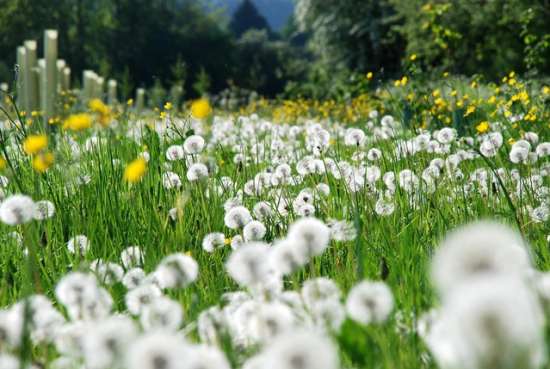5 Reasons to Let Your Lawn Go – Memorial Day Edition

It’s Memorial Day weekend and everyone is outside. Like the groundhogs of summer, people are peeking out, taking a stroll. They’re surmising maybe what the electric bill will be and just how many hot days will come to pass between now and Labor Day. Here in New York, the Fleet is in town, reminding us, yes, it’s okay to wear white now, and tall ships are sailing up the Hudson. But outside the city, barbeque grills are being rolled onto lawns all across suburbia, a little army of steel-hooded charcoal and gas fires, celebrating the American victory over the woods and meadows native to the land by a brief march. Just to there. Far enough that we won’t light the house on fire. I guess it would be harder to barbeque in a meadow but the American lawn makes me a little sad. We go to such lengths to make them look pretty and they themselves would rather be wild. So, here’s five reasons to let them go.
1. Grass is Greedy for Water
Doesn’t seem like a big deal on first glance. Everything dies without water; life needs water. That’s why astrophysicists are always looking for little molecules of H20 in outer space. Organic chemistry seems to require the stuff to be organic. But lawns in the amount we grow ’em are extremely thirsty. In the United States, the lawn is the single biggest irrigated crop and we use 7 billion gallons of water a day to maintain it. Times that by 365 days a year. I did. And my calculator cried “2.555e+12” it was so freaked out. Lawns are for the United Kingdom and Ireland because there it rains reliably and regularly.
2. Lawns Are Lying Liars
A good-looking lawn is a deceptive lawn. Its lush greenness might speak softly of nature and balance and health but no lawn got so good-looking, lush, and green by natural DNA. For a lawn to flourish in the United States, it doesn’t take just copious amounts of water. It takes copious amounts of fertilizer and weedkillers too. These chemicals are not good for living things besides turfgrass. There’s a reason why even in the TruGreen commercials they show their happy lawn care specialist applying their product in big heavy gloves, workboots and goggles. You’re not supposed to get it on your skin. Those little yellow flags they leave on your lawn should be a lot bigger.
3. Blades of Grass are Nazi Conformists
When I was a young’en, my parents bought a brand new house. The neighborhood was new. Woods had been where our house stood just months before. For the first toddling years of my life, I remember catching frogs all over our lawn. But as my father cared for our lawn – and he was immaculately responsible about his lawn care – the frogs disappeared. Those little amphibians could take very little of the increasing chemical stew. But it’s not just the nematode/animal diversity that is sacrificed to have a uniformly thick and green carpet. Food diversity is also sacrificed. As food naturalist Michael Pollan often says, monoculture is no good. A reliance on monoculture – i.e. Every blade of grass will be genetically the same so we can control its properties – is what leaves crops open to mass die-offs and creates starvation. Learn about Ireland’s Great Potato Famine, a monoculturing disaster. Taking out lawns in order to grow local and seasonal produce would be a pretty good thing because you can’t eat your lawn.
4. Mow, Mow, Mow Your Lawn
If you’re mowing, trimming, watering, and fertilizing your own lawn, you know. It’s zen the first couple of times a season, then it’s a chore. And if you’re paying someone to take care of your lawn for you, have you thought of how many hours of work you put in to make the money to pay their bill? What you are getting out of this lawn thing again? You can’t eat it. It won’t hug you. All this lawn maintenance, just because the neighbors are doing it too? Year in, year out, a lawn is a time suck.
5. Green on the Grass is Less Green in Your Pocket
America collectively spends 30 billion dollars a year on lawn care. First, there’s the money you spend on your lawn to gas up your own mower (or your landscaper). Well, maybe you don’t gas up your landscaper exactly. There’s the dough you drop on fertilizer and weed killer. There’s the money to maintain your sprinkling system and the water bill too. BUT THEN, there are the collective lawn expenses. Beyond the thirty billion. There are expenses that trickle into your water bill and electric bill and tax bill. You never think about these. Chemicals once put onto lawns have to be taken out of the run-off water that is processed to be piped back into your house. The more we fertilize, the more it costs to clean. In fact, water processing is so expensive (and water becoming so rare) that in Las Vegas, it’s now illegal to build new homes with lawns. Vegas is actually paying residents $40,000 an acre to rip up existing lawns and plant indigenous (desert) vegetation. Then there’s the electric. In terms of power costs, California is the worst example. Twenty percent of their electricity goes to moving water around the state. And underneath all the water and electric companies are municipalities, taxing you to subsidize them.
So, go now, and push that barbeque to its grilling spot and have a nice Memorial Day. But when the meat-smoke clears from your eyes, please take a look at the lawn pushing up around your flip-flops and consider if you could maybe let the Sisyphean struggle of keeping it up, go. Maybe next year, you could take out a great section of it and plant some vegetables and throw them on the grill, too.


